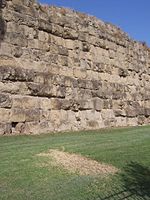Italia (in both the Latin and Italian languages; also referred to as Roman Italy) was the homeland of the ancient Romans. According to Roman mythology, Italy was the ancestral home promised by Jupiter to Aeneas of Troy and his descendants, Romulus and Remus, who were the founders of Rome. Aside from the legendary accounts, Rome was an Italic city-state that changed its form of government from Kingdom to Republic and then grew within the context of a peninsula dominated by the Gauls, Ligures, Veneti, Camunni and Histri in the North, the Etruscans, Latins, Falisci, Picentes and Umbri tribes (such as the Sabines) in the Centre, and the Iapygian tribes (such as the Messapians), the Oscan tribes (such as the Samnites) and Greek colonies in the South.
The consolidation of Italy into a single entity occurred during the Roman expansion in the peninsula, when Rome formed a permanent association with most of the local tribes and cities. The strength of the Italian confederacy was a crucial factor in the rise of Rome, starting with the Punic and Macedonian wars between the 3rd and 2nd century BC. As Roman provinces were being established throughout the Mediterranean, Italy maintained a special status which made it domina provinciarum ("ruler of the provinces"), and – especially in relation to the first centuries of imperial stability – rectrix mundi ("governor of the world") and omnium terrarum parens ("parent of all lands"). Such a status meant that, within Italy in times of peace, Roman magistrates also exercised the imperium domi (police power) as an alternative to the imperium militiae (military power). Italy's inhabitants had Latin Rights as well as religious and financial privileges.
The period between the end of the 2nd century BC and the 1st century BC was turbulent, beginning with the Servile Wars, continuing with the opposition of aristocratic élite to populist reformers and leading to a Social War in the middle of Italy. However, Roman citizenship was recognized to the rest of the Italians by the end of the conflict and then extended to Cisalpine Gaul when Julius Caesar became Roman Dictator. In the context of the transition from Republic to Principate, Italy swore allegiance to Octavian Augustus and was then organized in eleven regions from the Alps to the Ionian Sea.
More than two centuries of stability followed. Several emperors made notable accomplishments in this period: Claudius incorporated Britain into the Roman Empire, Vespasian subjugated the Great Revolt of Judea and reformed the financial system, Trajan conquered Dacia and defeated Parthia, and Marcus Aurelius epitomized the ideal of the philosopher king.
The Crisis of the Third Century hit Italy particularly hard and left the eastern half of the Empire more prosperous. In 286 AD, the Emperor Diocletian moved Imperial residence undertaking the western provinces (the later Western Roman Empire) from Rome to Mediolanum. Meanwhile, the islands of Corsica, Sardinia, Sicily and Malta were added to Italy by Diocletian in 292 AD, and Italian cities such as Mediolanum and Ravenna continued to serve as de facto capitals for the West.
The Bishop of Rome had gained importance gradually from the reign of Constantine, and was given religious primacy with the Edict of Thessalonica under Theodosius I. Italy was invaded several times by the wandering Germanic peoples and fell under the control of Odoacer, when Romulus Augustus was deposed in 476 AD. Except for about more than a decade between the end of the Gothic War in mid-550s and Lombard invasion of Italy in 568 when (Eastern) Roman Empire reunited Italy, no single authority was established in Italy as a whole until it was reunited in the 19th century by the House of Savoy in the Kingdom of Italy, which became the present-day Italian Republic in 1946.










